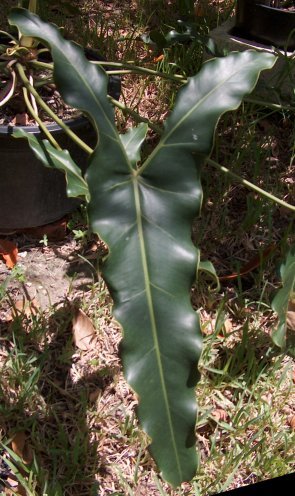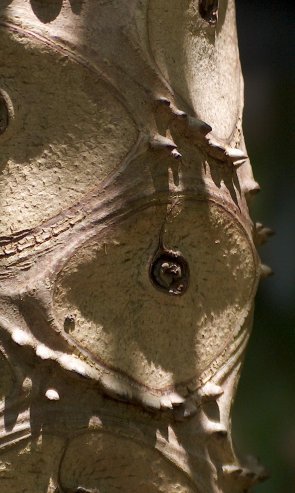





These are among the largest of the plants in the genus Philodendron, producing thick trunk-like stems and cord-like roots that can wrap around nearby trees or anchor to the ground like guy wires. Known also as "tree philodendrons", they are spectacular in the tropical landscape but can become unwieldy indoors . . .
(Editor's Note: This article was originally published on December 12, 2008)
Standing Tall
Tropical and indoor plant lovers are almost all familiar with a plant known commonly as "Philodendron selloum". This plant is the most often encountered member of the "Tree Philodendrons", or technically, the Meconostigma group within the genus Philodendron. The true name of the plant is Philodendron bipinnatifidum (see thumbnail picture at right), and in growing habit, leaves and overall plant size, these are quite variable. I've seen large landscape beds of these plants growing in south Florida, where they grow to considerable size and height. Often taller than 5 feet and with an equal spread, I found that locating two that were identical was a challenge. As a hybridizer, that suggests to me that the commercially available specimens are, in all likelihood, hybrids rather than pure or true species. Nonetheless, they are very tropical looking and have been a standard indoor and tropical landscape plant for many years.
 With very few exceptions, the plants in this group are varying shades of green overall. Although I suspect that somewhere in south America can be found a Meconostigma with reddish leaves, I've never seen one or heard of one in existence. They do have a range of leaf shapes and some variation in trunk or stem characteristics. Some, like P. speciosum, have entire leaf blades, while a number of types similar to P. bipinnatifidum have shallow to deeply cut leaves. One species, P. stenolobum (see picture to left0, has long, thin, dark green leaves on long petioles, and another, P. goeldii, has leaves that look, at first glance, like those found on a Schefflera plant. One well-known Philodendron that belongs to this group is P. 'Xanadu', a much smaller growing plant that at first doesn't look like it belongs with the much larger types. A close look at the trunks that develop, however, shows them to be like miniature trunks of the larger types. For more information about the Xanadu, see my article here.
With very few exceptions, the plants in this group are varying shades of green overall. Although I suspect that somewhere in south America can be found a Meconostigma with reddish leaves, I've never seen one or heard of one in existence. They do have a range of leaf shapes and some variation in trunk or stem characteristics. Some, like P. speciosum, have entire leaf blades, while a number of types similar to P. bipinnatifidum have shallow to deeply cut leaves. One species, P. stenolobum (see picture to left0, has long, thin, dark green leaves on long petioles, and another, P. goeldii, has leaves that look, at first glance, like those found on a Schefflera plant. One well-known Philodendron that belongs to this group is P. 'Xanadu', a much smaller growing plant that at first doesn't look like it belongs with the much larger types. A close look at the trunks that develop, however, shows them to be like miniature trunks of the larger types. For more information about the Xanadu, see my article here.
 One species, P. mello-barretoanum, has jaggedly pinnate leaves and heavy trunks with actual thorns on them (see photo at right). To demonstrate how heavy they are, I had obtained a trunk section with leafy head and needed to cut off a piece so I could fit the rest into a pot. I needed to use a regular pruning saw such as I'd use for a hardwood tree branch to cut this trunk! Plus, the thorns made this job the kind that requires heavy leather work gloves. Both P. mello-barretoanum and P. goeldii are more sensitive to cold weather than P. bipinnatifidum. In fact, most of the more exotic species, such as P. goeldii, are likely to be available only from collectors as well as requiring greenhouse culture in most areas.
One species, P. mello-barretoanum, has jaggedly pinnate leaves and heavy trunks with actual thorns on them (see photo at right). To demonstrate how heavy they are, I had obtained a trunk section with leafy head and needed to cut off a piece so I could fit the rest into a pot. I needed to use a regular pruning saw such as I'd use for a hardwood tree branch to cut this trunk! Plus, the thorns made this job the kind that requires heavy leather work gloves. Both P. mello-barretoanum and P. goeldii are more sensitive to cold weather than P. bipinnatifidum. In fact, most of the more exotic species, such as P. goeldii, are likely to be available only from collectors as well as requiring greenhouse culture in most areas.
P. bipinnatifidum, or "Selloum", is just about the easiest to grow of all the species, but it can also grow quite large and get gangly indoors with smallish leaves on long petioles. This observation is one reason why, years ago, I began to experiment with hybridizing the plants in this group because I had been fortunate to obtain a couple of species that were much smaller growers than the "Selloum". Both the smaller species and some of the hybrids resulting would seem to be much better candidates for indoor plant use than the big growers. Of course, I couldn't resist the fun of mixing up the larger growers, so I came up with P. bipinnatifidum x P. goeldii, which I call "African Fantasy", and P. bipinnatifidum x P. stenolobum, just to mention a couple out of many I've done.
You can view a good photo of P. goeldii at PlantFiles, Philodendron goeldii.
Image credit: LariAnn Garner and Public Domain
Copyright © www.100flowers.win Botanic Garden All Rights Reserved